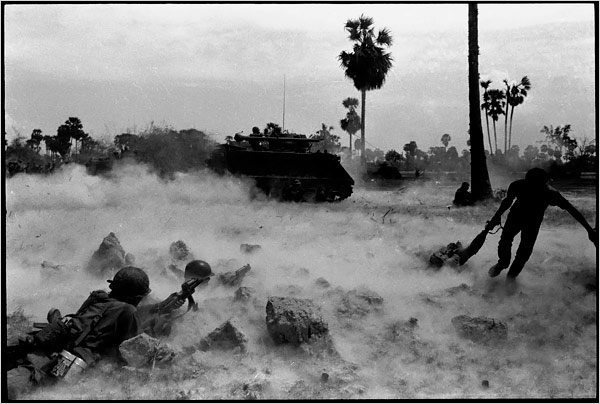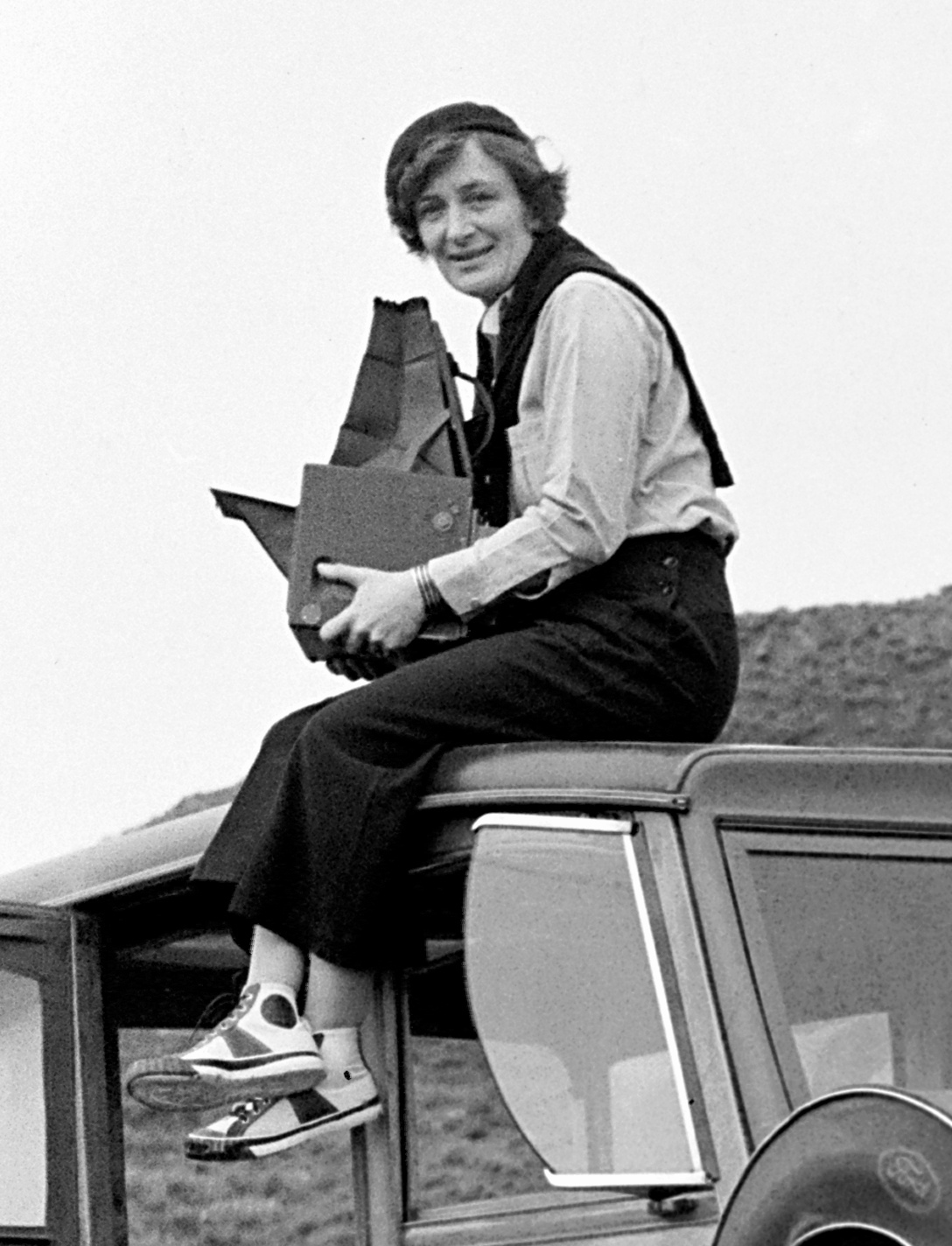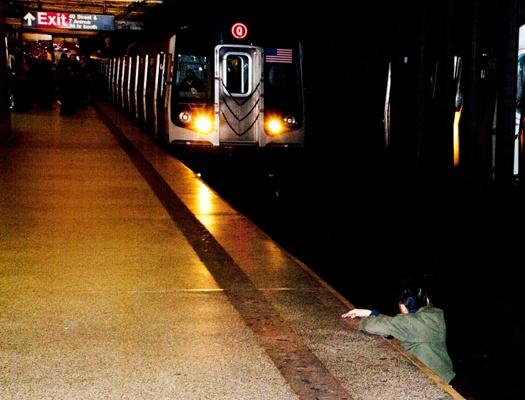Photo by Ed Clark
Principle 1: Subject's expression
The subject's expression is one of the main components of this image. He expresses pure sadness and there is a feeling of grief. There are tears rolling down his face that adds more emotion to the photograph. The man continues to play his accordion, even though he is visibly upset. It seems like playing the song was a duty. This is a candid shot of the individual. The body language fits the subject's facial expression.
Principle 2: Is the image black & white or color?
The photograph is black & white. I think that the black and white adds to the image. It gives all of the attention of the audience on the main subject. If there was color, the eye of the viewer might wander around the image. I personally think that the photograph looks better as a black and white photograph. It does not need to be in color and I think that the color would take away from the photograph.
Principle 3: What feelings does the image create?
This image creates a feeling of sadness. Also, there is a sense of loss created by the expression on the man. The fact that the man is crying helped create a feeling of despair and shows that the man is powerless in this situation. I think that this image grows on me. The more I look at the image, the more I begin to wonder what is truly happening to the man. Also, I question the expressions on the faces of the people behind the man. They do not seem to display the same amount of emotion towards the situation.
The image above conveys very strong emotions. In the forefront of the photograph is an African American Navy officer playing an accordion. The man has tears streaming down his face as he looks forward. There are several people in the background of the photograph. All of the people seem to be expressing some type of negative emotion. One woman is crying. The other people in the picture seem to have a somber look on their faces. However, each of the other people in the background seem to be staring at the man, as if it is wrong for him to be crying. I found it interesting that there was only one African American man in the photograph and he is showing the most emotion out of everyone in the photograph. If the photograph was just of the African American man, it would give off a feeling of sadness. However, the people in the background add an element of confusion and uncertainty. In
Professor Nordell's video on photojournalism and bias, Professor Nordell speaks of the illustration that was a rendition of the assassination attempt on Queen Victoria. Professor Nordell states that William Wordsworth felt that pictures in the press were not good and that "people who were fed a diet of pictures might forget important things like reading and writing". After completing
further research on the image by Ed Clark, I discovered that the image was taken of a Navy CPO named Graham Jackson playing "Goin' Home" as President Franklin D. Roosevelt's lifeless body is taken from the Warm Springs Foundation after having a stroke. I pondered the quote from William Wordsworth after watching Professor Nordell's video. In this case, I think that the picture does not take away anything from anyone. I think that it displays raw emotion and lets people gain an understanding of the feelings presented during this tough time in American history. I think that pictures do not take away from reading and writing, but these photographs aid in gaining a better understanding and seeing situations from different points of view.
The Great Depression was a very hard time for Americans. According to
history.com, the Great Depression, "was the deepest and longest lasting economic downturn in the history of the Western industrialized world". The photography that was taken during this time attempted to depict the hardships of Americans during this time. In
an article on medium.com, Donald Weber states that,"Photographers choose where their frame goes. They selectively choose what the audience will see, will believe". During Dorothea Lange's time photographing Americans that lived during the Great Depression, she attempted to portray the individuals just as they were and display the realistic nature of the Great Depression. She specifically chose to show the mother and child with blank expressions on their faces and dirty clothes. It looks like the family is struggling day by day. The Great Depression did not discriminate about the families that it affected. It affected everyone. Those who were employed lost their jobs and faced home foreclosure. Those who worked on a farm faced the Dust Bowl and most of the crops went unharvested. It was very hard for Americans to lead normal and healthy lives during this time.
This photograph shows the truth to me. In an
article on aarp.org, Patrick Kiger states that words can only do so much, but photographs, "often take hold of our hearts and reach us on a more primal emotional level". This photograph is full of emotion and triggers feelings of sadness in the viewer. The viewer can only imagine what the families had to go through during this extremely hard time. I think that most photographs of families during the Great Depression truly take hold of our hearts. The face of the mother is filled with hopelessness and she almost looks as if she has given up. The child is covered in dirt and has an expression of worry. The family is in a car and looks like they are on the move. During the Great Depression, families would pack up their belongings and search for work, which might be what this family was attempting to do. The family does not have much and desperately clings onto one another for support. I think that this photograph accurately displays the hard times faced by Americans during the Great Depression.

Photo by Dorothea Lange
Principle 1: Obvious main subject
This photograph has two obvious main subjects. The mother and the child are the main focus of the image. The two take up the majority of the picture. There is not a lot of space for other things to be in the background of the photograph. The main subjects do not crowd the edges of the photograph, but take up just enough space to be considered the main subjects.
Principle 2: Background compliments or detracts from composition
I believe that the background of this image compliments the composition. It looks like the mother and child are in a car. In the background of the image, you can see that there is a cardboard box and another child. The child is not fully shown in the image, so the child does not compete for attention with the two main subjects. The background is out of focus and becomes less clear.
Principle 3: Does the image remind you of any work of art or photograph you have seen?
This photograph reminds me another photograph by Dorothea Lange titled "Migrant Mother". Both of the photographs were taken during the Great Depression. Both of the photographs are of a mother and a child. In both of the photographs, the mother looks like she is facing a struggle. I feel as if Dorothea Lange was looking to capture a feeling of despair and struggle by photographing families during the Great Depression.
The second photograph that is displayed below does not show the truth in my opinion. I think that the main goal of the photography during the Great Depression was to show just how terrible life was for the people living during this time. The hardships were to be displayed through the photographs. I think that this photograph does not show how terrible the Great Depression was. This photograph could be used to show that even during hard times, there is still hope. However, I think that the first photograph has more truth to it. As stated in
Professor Nordell's second video, the truth of a photograph "depends on the lens choice, angle, and what perspective you're trying to get across with your photograph". There are many aspects of a photograph that determine the level of truth. The lens choice and the angle do not determine much in this photograph. However, the perspective is important. Perspective is the way you see something. The way I see this picture is that it is a mother and a child laughing. Without knowing the time frame of the photograph, it can be difficult to understand what the photographer was trying to portray with this photograph. I think that the other photograph clearly displays what the photographer was trying to express.
The two photographs were very interesting to view side by side. This photograph has both mother and child smiling. I pondered whether this photograph was staged or not. If this photograph wasn't staged, was the first photograph staged? There is no dirt on the child's face in the photograph below. The mother seems to be very happy and in high spirits. This photograph does not seem typical for that of a family during the Great Depression. Both photographs convey very different and opposite emotions, yet were taken at the same time. Either photograph could be seen as the truth or not the truth, depending on a person's opinion. As
Shahidul Alam stated in the video posted by Conscious Action Network, "a story has many truths at many levels". There is not just one opinion that is right regarding the truth of photojournalism. I think that the first photograph is more truthful because it shows the devastating nature of the Great Depression.
After reading about the four ways of knowing in
the article on toktalk.net, I believe that the reason I can determine which is the truth and which is not is because of language/authority. This means that the reason you know something is because someone who knows more than you told you or you read the information somewhere. My knowledge of the Great Depression was taught by teachers throughout middle school and high school. Also, any information that I did not learn from my teachers was learned from research on the internet or from books. I know that the Great Depression was one of the toughest times in America and it was not necessarily a time filled with much happiness.
Photo by Dorothea Lange
Principle 1: Keep it simple
The composition of the photograph is simple. It is not cluttered. There are two main subjects that take up the majority of the photograph. Other than the two people, there is only a cardboard box in the background of the photograph. Everything else in the photograph is not distinguishable. I think this is helpful because the focus remains on the two people in the photograph. The viewers eye does not wander.
Principle 2: Use of lines
Although it is not very clear, the use of lines in the photograph help create the setting. The lines at the top of the photograph and the lines going down the left side of the photograph create the idea that the mother and child are in some type of vehicle. This makes it known that they are traveling to some place. The lines create a box around the mother and child, which keeps the viewers eye focused on the main subjects.
Principle 3: In or out of focus
The photograph is in focus. The main subject and background are in focus and do not seem slurry at all. The viewer is able to see texture on the jacket of the mother and can even read the words that are printed on the cardboard box. I think that it is good that this image is in focus. The image would become less clear and would lose some value if it was out of focus.
























(1).jpg)







